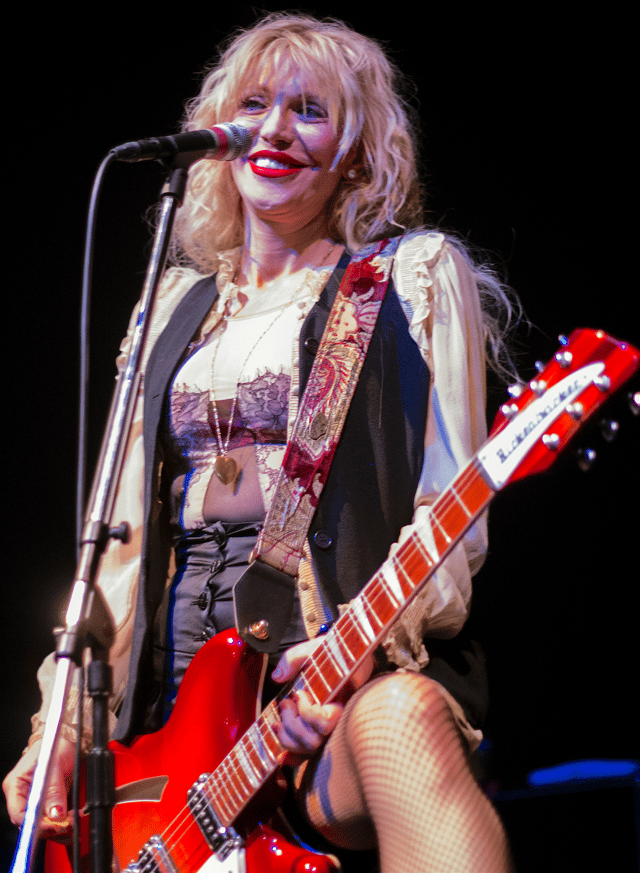Courtney Love
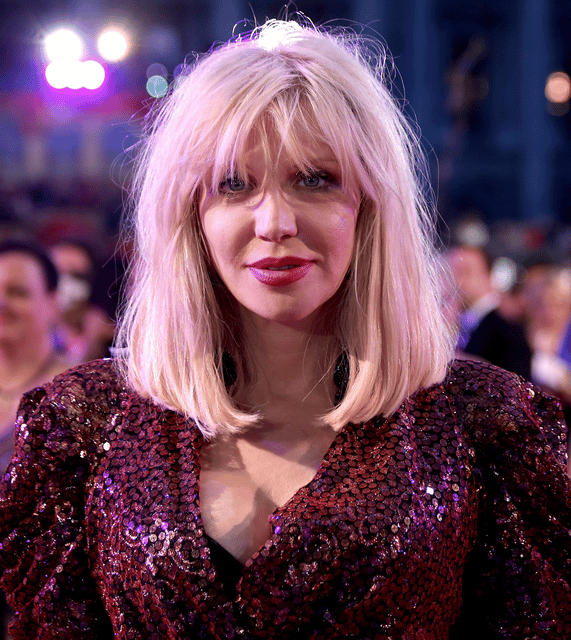
Courtney Love

Courtney Love | |
|---|---|
| Born | Courtney Michelle Harrison (1964-07-09)July 9, 1964 San Francisco, California, U.S. |
| Occupation |
|
| Years active | 1981–present |
| Spouse(s) |
|
| Children | Frances Bean Cobain |
| Relatives |
|
| Musical career | |
| Origin | Portland, Oregon, U.S. |
| Genres |
|
| Instruments |
|
| Labels |
|
| Associated acts |
|
| Signature | |
 | |
Courtney Michelle Love (born Courtney Michelle Harrison; July 9, 1964) is an American singer, songwriter and actress. A figure in the punk and grunge scenes of the 1990s, Love's career has spanned four decades. She rose to prominence as the lead vocalist of the alternative rock band Hole, which she formed in 1989. Love has drawn public attention for her uninhibited live performances and confrontational lyrics, as well as her highly publicized personal life following her marriage to Nirvana frontman Kurt Cobain.
Born to countercultural parents in San Francisco, Love had an itinerant childhood, but was primarily raised in Portland, Oregon, where she played in a series of short-lived bands and was active in the local punk scene. After briefly being in a juvenile hall, she spent a year living in Dublin and Liverpool before returning to the United States and was cast in the Alex Cox films Sid and Nancy (1986) and Straight to Hell (1987). She formed Hole in Los Angeles, receiving attention from underground rock press for the group's 1991 debut album, produced by Kim Gordon. Hole's second release, Live Through This (1994), was met with critical accolades and multi-platinum sales. In 1995, Love returned to acting, earning a Golden Globe Award nomination for her performance as Althea Leasure in Miloš Forman's The People vs. Larry Flynt (1996), which established her as a mainstream actress. The following year, Hole's third album, Celebrity Skin (1998), was nominated for three Grammy Awards.
Love continued to work as an actress into the early 2000s, appearing in big-budget pictures such as Man on the Moon (1999) and Trapped (2002), before releasing her first solo album, America's Sweetheart, in 2004. The next years were marked by publicity surrounding Love's legal troubles and drug addiction, which resulted in a mandatory lockdown rehabilitation sentence in 2005 while she was writing a second solo album. That project became Nobody's Daughter, released in 2010 as a Hole album but without the former Hole lineup. Between 2014 and 2015, Love released two solo singles and returned to acting in the network series Sons of Anarchy and Empire.
Love has also been active as a writer; she co-created and co-wrote three volumes of a manga, Princess Ai, between 2004 and 2006, and wrote a memoir, Dirty Blonde: The Diaries of Courtney Love (2006).
Courtney Love | |
|---|---|
| Born | Courtney Michelle Harrison (1964-07-09)July 9, 1964 San Francisco, California, U.S. |
| Occupation |
|
| Years active | 1981–present |
| Spouse(s) |
|
| Children | Frances Bean Cobain |
| Relatives |
|
| Musical career | |
| Origin | Portland, Oregon, U.S. |
| Genres |
|
| Instruments |
|
| Labels |
|
| Associated acts |
|
| Signature | |
 | |
Biography
1964–1981: Childhood and education
Courtney Michelle Harrison[1] was born on July 9, 1964, at Saint Francis Memorial Hospital in San Francisco, California,[6] the first child of psychotherapist Linda Carroll (née Risi) and Hank Harrison, a publisher and road manager for the Grateful Dead.[7][8] Love's godfather is the founding Grateful Dead bassist Phil Lesh.[9][10] Her mother, who was adopted at birth and raised by a prominent Italian-Catholic family in San Francisco,[11] was later revealed to be the biological daughter of novelist Paula Fox;[12][13] Love's maternal great-grandmother was screenwriter Elsie Fox.[14] According to Love, she was named after Courtney Farrell, the protagonist of Pamela Moore's 1956 novel Chocolates for Breakfast.[15] She is of Cuban, English, German, Irish, and Welsh descent.[16]
Love spent her early years in the Haight-Ashbury district of San Francisco until her parents' 1969 divorce, spurred by her mother's allegations that her father had fed Courtney LSD when she was a toddler.[18][19] Though he denied the claim, full custody of Love was awarded to her mother.[20] In 1970, Carroll relocated with Love to the rural community of Marcola, Oregon where they lived along the Mohawk River[21] while she completed her psychology degree at the University of Oregon.[22] There, Love was adopted by her then-stepfather, Frank Rodriguez.[21] He and her mother had two daughters and a son who died in infancy of a heart defect when Love was ten; they also adopted a boy.[23] Love attended a Montessori school in Eugene, where she struggled academically and had trouble making friends.[24][25] At age nine, a psychologist noted that she exhibited signs of autism.[17][24][26]
In 1972, Love's mother divorced Rodriguez, remarried, and moved the family to Nelson, New Zealand.[27] There, she enrolled Love at Nelson College for Girls,[28] from which she was soon expelled.[29] In 1973, she was sent back to live in the United States, where she was raised in Portland, Oregon[30] by her former stepfather and other family friends.[31][32] During this time, her mother gave birth to two of Love's other half-brothers.[21] At age fourteen, she was arrested for shoplifting a T-shirt from a Woolworth's,[33] and was sent to Hillcrest Correctional Facility, a juvenile hall in Salem, Oregon.[25][34] She was subsequently placed in foster care until she became legally emancipated at age 16.[19] She supported herself by working illegally as a topless dancer[35] at Mary's Club in downtown Portland[36] adopting the last name "Love" to conceal her identity; she later adopted "Love" as her surname.[21] She also worked various odd jobs, including picking berries at a farm in Troutdale, Oregon,[37][38] and as a disc jockey at a gay disco.[39] During this time, she enrolled at Portland State University, studying English and philosophy.[40][41] Love has said that she "didn't have a lot of social skills,"[42] and that she learned them while frequenting gay clubs and spending time with drag queens.[43]
In 1981, she was granted a small trust fund that had been left by her adoptive grandparents, which she used to travel to Dublin, Ireland, where her biological father was living.[44] While there, she enrolled in courses at Trinity College, studying theology for two semesters.[45][46] She would later receive honorary patronage from Trinity's University Philosophical Society in 2010.[47] After leaving Trinity, Love relocated to Liverpool, where she became acquainted with musician Julian Cope and his band, The Teardrop Explodes, and briefly lived in his house.[48] "They kind of took me in", she recalled. "I was sort of a mascot; I would get them coffee or tea during rehearsal."[49] In Cope's autobiography Head-On, Love is referred to as "the adolescent."[50] After spending a year abroad, Love returned to Portland: "I thought that [going to the United Kingdom] was my peak life experience," she said in 2011. "—that nothing else [would] happen to me again."[51] In 1983, she took short-lived jobs working as an erotic dancer in Japan and later Taiwan, but was deported after the club was shut down by the government.[52][53]
1982–1987: Early music projects and film
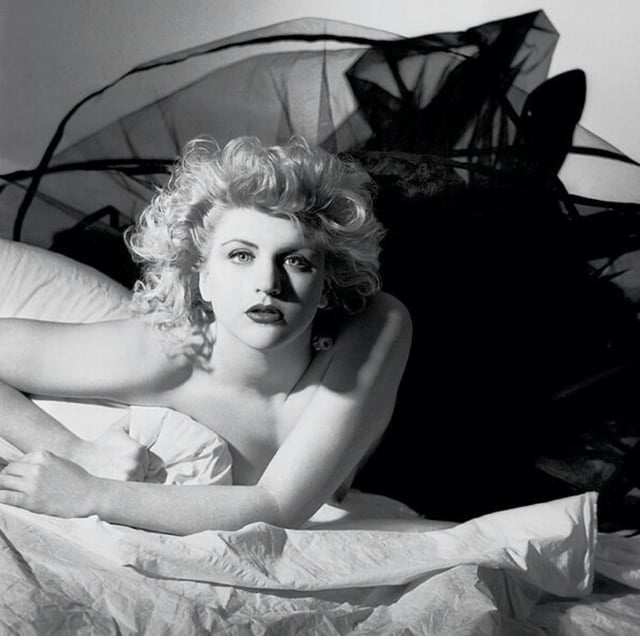
Love in a publicity headshot for Straight to Hell, 1986
Love began several music projects in the 1980s, first forming Sugar Babylon (later Sugar Babydoll)[2] in Portland with her friends Ursula Wehr and Robin Barbur.[55] In 1982, Love attended a Faith No More concert in San Francisco and convinced the members to let her join as a singer.[56][57] The group recorded material with Love as a vocalist, but she was subsequently kicked out of the band. According to the Faith No More keyboardist Roddy Bottum, who remained Love's friend in the years after, the band wanted a "male energy."[58]
She later formed the Pagan Babies with friend Kat Bjelland, whom she met at the Satyricon club in Portland in 1984.[59] As Love later reflected, "The best thing that ever happened to me in a way, was Kat."[60] Love asked Bjelland to start a band with her as a guitarist, and the two moved to San Francisco in June 1985, where they recruited bassist Jennifer Finch and drummer Janis Tanaka.[61] According to Bjelland, "[Courtney] didn't play an instrument at the time" aside from keyboards, so Bjelland would transcribe Love's musical ideas on guitar for her.[25] The group played several house shows and recorded one 4-track demo before disbanding in late 1985.[61][62] After Pagan Babies, Love moved to Minneapolis, where Bjelland had formed the group Babes in Toyland, and briefly worked as a concert promoter before returning to California.[25] Drummer Lori Barbero and bassist Maureen Herman recalled Courtney's departure 'She lived in my house for a little while. And then we did a concert at the Orpheum. It was in 1988. It was called O-88 with Butthole Surfers, Cows & Bastards, Run Westy Run, and Babes in Toyland. And I guess Maureen took Courtney to the airport after she stole all the money'. 'She stayed and stayed, and then the next day she wanted me to take her to the airport. And so I drove her to the airport. She had just had some weird fight with the guy at the desk, and then she left. She said, “I'm going to go to L.A. and I'm going to get my face done and I'm going to be famous.' - 'And then she did' [63]
Deciding to shift her focus to acting, Love enrolled at the San Francisco Art Institute[64] and studied film under experimental director George Kuchar.[65][66] Love was featured in one of his short films, titled Club Vatican.[67][68][69] In 1985 she submitted an audition tape for the role of Nancy Spungen in the Sid Vicious biopic Sid and Nancy (1986), and was given a minor supporting role by director Alex Cox.[70][71] After filming Sid and Nancy in New York City, she worked at a peep show in Times Square and squatted at the ABC No Rio social center and Pyramid Club in the East Village.[72][73] The same year, Cox cast her in a leading role in his film Straight to Hell (1987),[74] a spaghetti western starring Joe Strummer and Grace Jones filmed in Spain in 1986.[75] The film caught the attention of Andy Warhol, who featured Love in an episode of Andy Warhol's Fifteen Minutes.[76] She also had a part in the 1988 Ramones music video for "I Wanna Be Sedated," appearing as a bride among dozens of party guests.[77][78][79]
In 1988, Love aborted her acting career and left New York, returning to the West Coast, citing the "celebutante" fame she'd attained as the central reason.[80] She returned to stripping in the small town of McMinnville, Oregon, where she was recognized by customers at the bar.[81] This prompted Love to go into isolation, so she relocated to Anchorage, Alaska, where she lived for three months to "gather her thoughts," supporting herself by working at a strip club frequented by local fishermen.[82] "I decided to move to Alaska because I needed to get my shit together and learn how to work", she said in retrospect. "So I went on this sort of vision quest. I got rid of all my earthly possessions. I had my bad little strip clothes and some big sweaters, and I moved into a trailer with a bunch of other strippers."[83]
1988–1991: Beginnings of Hole
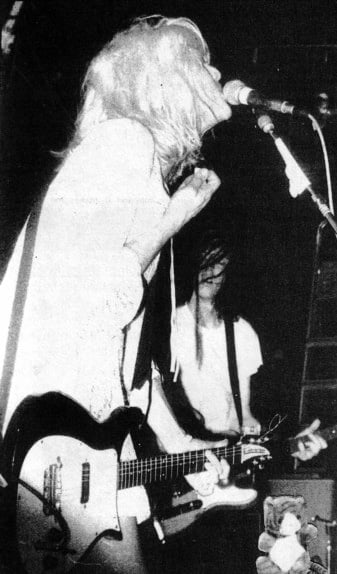
Love performing with Hole, 1989
"She was the most gung-ho person I've ever met ... She gave 180%. I've worked with some people that you've had to coax the performance out of them. With Courtney, there was no attitude." –Don Fleming, who co-produced Hole's debut album with Kim Gordon, on Love[84]
At the end of 1988, Love taught herself to play guitar and relocated to Los Angeles,[85] where she placed an ad in a local music zine: "I want to start a band. My influences are Big Black, Sonic Youth, and Fleetwood Mac."[86] Love recruited lead guitarist Eric Erlandson; Lisa Roberts, her neighbor, as bassist; and drummer Caroline Rue, whom she met at a Gwar concert.[87] Love named the band Hole after a line from Euripides' Medea[88] ("There is a hole that pierces right through me")[89] as well as a conversation she had had with her mother, in which she told her that she couldn't live her life "with a hole running through her."[90] Just prior to forming Hole, Love married James Moreland (vocalist of The Leaving Trains) in Las Vegas, a marriage she later said was "a joke," ending in an annulment filed by Love several months later.[91] After forming Hole, she and bandmate Eric Erlandson had a romantic relationship that lasted over a year.[92]
In the band's formative stages, Love continued to work at strip clubs in Hollywood (including Jumbo's Clown Room and the Seventh Veil),[86]saving money to purchase backline equipment and a touring van,[93] while rehearsing at a studio in Hollywood that was loaned to her by the Red Hot Chili Peppers.[94] Hole played their first show in November 1989 at Raji's, a rock club in central Hollywood.[95] The band's debut single, "Retard Girl", was issued in April 1990 through the Long Beach indie label Sympathy for the Record Industry, and was given airtime by Rodney Bingenheimer's show on local rock station KROQ.[25] That fall, the band appeared on the cover of Flipside, a Los Angeles-based punk fanzine.[87] In early 1991, the band released their second single, "Dicknail", through Sub Pop Records.[96]
With no wave, noise rock and grindcore bands being major influences on Love,[87] Hole's first studio album, Pretty on the Inside, captured a particularly abrasive sound and contained disturbing, graphic lyrics,[97][98] described by Q magazine as "confrontational [and] genuinely uninhibited."[99] The record was released in September 1991 on Caroline Records, produced by Kim Gordon of Sonic Youth with assistant production from Gumball's Don Fleming; Love and Gordon had initially met when Hole opened for Sonic Youth during their promotional tour for Goo at the Whisky a Go Go in November 1990.[100] In early 1991, Love sent Gordon a personal letter asking her to produce the record for the band, to which she agreed.[98][101]
Though Love would later say it was "unlistenable" and "[un]melodic,"[102] the album received generally positive critical reception from indie and punk rock critics[103] and was labeled one of the twenty best albums of the year by Spin magazine.[104] It also gained a following in the United Kingdom, charting at 59 on the UK Albums Chart,[105] and its lead single, "Teenage Whore", entered the country's indie chart at number one.[105] The underlying feminist slant of some of the album's songs led many to mistakenly tag the band as being part of the riot grrrl movement,[106] a movement with which Love did not associate.[107][108] The band toured in support of the record, headlining with Mudhoney in Europe; in the United States, they opened for the Smashing Pumpkins,[109] and performed at CBGB in New York City.[110]
During this tour, Love briefly dated Billy Corgan of the rock band The Smashing Pumpkins[111] before formally dating Nirvana frontman Kurt Cobain.[112] It is uncertain when they first met, and there are varying accounts of how they came to know one another.[3] Journalist Michael Azerrad states that the two met in 1989 at the Satyricon nightclub in Portland, Oregon, though Cobain biographer Charles Cross has claimed the date was actually February 12, 1990, and that Cobain playfully wrestled Love to the floor after she commented to him in passing that he looked like Dave Pirner of Soul Asylum.[114] According to Love, she first met him at a Dharma Bums show in Portland,[115][116] while Love's bandmate Eric Erlandson stated that both he and Love were formally introduced to Cobain in a parking lot after a Butthole Surfers/L7 concert at the Hollywood Palladium on May 17, 1991.[92] Sometime in late 1991, Love and Cobain became re-acquainted through Jennifer Finch, one of Love's longtime friends and former bandmates.[117][118] and were officially a couple by the close of 1991.[119][120]
1992–1995: Live Through This and breakthrough
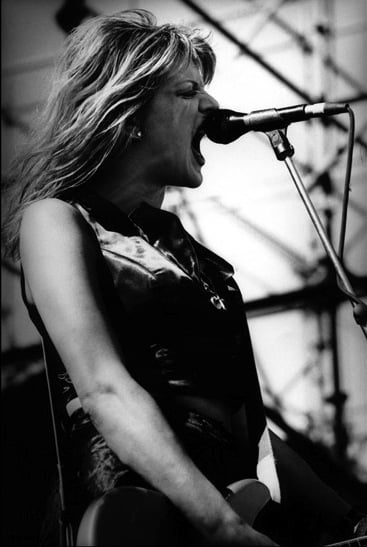
Love performing with Hole at Big Day Out, Melbourne, 1995
"Just marrying [him] created a mythology around me that I didn't expect for myself, because I had a very controlled, five-year plan about how I was going to be successful in the rock industry. Marrying Kurt, it all kind of went sideways in a way that I could not control and I became seen in a certain light–a vilified light that made Yoko Ono look like Pollyanna–and I couldn't stop it." –Love on her public image after marrying Kurt Cobain[121]
Shortly after completing the tour for Pretty on the Inside, Love married Cobain on Waikiki Beach in Honolulu, Hawaii on February 24, 1992.[122] She wore a satin and lace dress once owned by actress Frances Farmer, and Cobain wore plaid pajamas.[123] During Love's pregnancy, Hole recorded a cover of "Over the Edge" for a Wipers tribute album,[124] and recorded their fourth single, "Beautiful Son", which was released in April 1993. On August 18 of that year, the couple's only child, a daughter, Frances Bean Cobain, was born in Los Angeles.[122] The couple subsequently relocated to Carnation, Washington and then to Seattle.[125][126]
Love's first major media exposure came in a September 1992 profile of herself and Cobain for Vanity Fair by journalist Lynn Hirschberg, entitled "Strange Love."[127] After being asked to participate in a cover story for the magazine, Love was urged by her manager to accept the request.[128] In the year prior, Love and Cobain had developed a heroin addiction, and the profile painted the couple in an unflattering light and suggested that Love had been addicted to heroin during her pregnancy.[129] The article ultimately resulted in the Los Angeles Department of Children and Family Services investigating, and custody of Love and Cobain's newborn daughter, Frances, was temporarily awarded to Love's sister, Jaimee.[130] Love claimed she was misquoted by Hirschberg, and asserted that she had immediately quit using heroin during her first trimester after she discovered she was pregnant.[128][131][132] Love would later claim that the publication of the article had serious implications for her marriage as well as Cobain's mental state,[133][134][135] suggesting it was a factor in his suicide.[128][136]
On September 8, 1993, Love and Cobain made their only public performance together at the Rock Against Rape benefit in Hollywood, performing two acoustic duets of "Pennyroyal Tea" and "Where Did You Sleep Last Night."[137] Love also performed electric versions of two new Hole songs, "Doll Parts" and "Miss World," both written for the band's upcoming second album.[137] In October 1993, Hole recorded their second album, Live Through This, in Atlanta. The album featured a new lineup with bassist Kristen Pfaff and drummer Patty Schemel. Live Through This was released on Geffen's subsidiary label DGC in April 1994, four days after Cobain died of a self-inflicted gunshot wound in their Seattle home while Love was in rehab in Los Angeles.[138] In the following months, Love was rarely seen in public, holing up in her Seattle home with friends and family members. After the cremation of Cobain's remains, Love divided portions of his ashes, keeping some in a teddy bear and some in an urn.[139] In June 1994, she traveled to the Namgyal Buddhist Monastery in Ithaca, New York, where she had his ashes ceremonially blessed by Buddhist monks, and a portion were mixed into clay which was made into memorial sculptures.[139] On June 16, 1994, Hole's bassist Kristen Pfaff died of a heroin overdose in Seattle.[140] For the band's impending tour, Love recruited Canadian bassist Melissa Auf der Maur.[141]
Live Through This was a commercial and critical success,[142][143][144] hitting platinum RIAA certification in April 1995 and receiving numerous critical accolades.[78] The success of the record combined with Cobain's suicide resulted in a high level of publicity for Love, and she was featured on Barbara Walters' 10 Most Fascinating People in 1995.[145] Simultaneously, her erratic onstage behavior and various legal troubles during Hole's 1994–1995 world tour compounded the media coverage of her.[146]
Hole's performance on August 26, 1994 at the Reading Festival— Love's first public performance following Cobain's death[147][148]—was described by MTV as "by turns macabre, frightening and inspirational."[149] John Peel wrote in The Guardian that Love's disheveled appearance "would have drawn whistles of astonishment in Bedlam", and that her performance "verged on the heroic ... Love steered her band through a set which dared you to pity either her recent history or that of the band ... the band teetered on the edge of chaos, generating a tension which I cannot remember having felt before from any stage."[150] The band performed a series of riotous concerts over the following year, with Love frequently appearing hysterical onstage, flashing crowds, stage diving, and getting into fights with audience members.[147][151] One journalist reported that at the band's show in Boston in December 1994, "Love interrupted the music and talked about her deceased husband Kurt Cobain, and also broke out into Tourette syndrome-like rants. The music was great, but the raving was vulgar and offensive, and prompted some of the audience to shout back at her."[152]
The tour was also marked by a series of legal troubles for Love: In January 1995, she was arrested in Melbourne for disrupting a Qantas Airways flight after getting into an argument with a stewardess.[153] On July 4, 1995, at the Lollapalooza Festival in George, Washington, Love threw a lit cigarette at musician Kathleen Hanna before punching her in the face, alleging that Hanna had made a joke about her daughter.[154] She pleaded guilty to an assault charge and was sentenced to anger management classes.[155][156] In November 1995, two male teenagers attempted to sue Love for allegedly punching them during a Hole concert they attended in Orlando, Florida in March 1995. The judge ultimately dismissed the case on grounds that the teens "weren't exposed to any greater amount of violence than could reasonably be expected at an alternative rock concert."[157] Love would later say that she retained little memory of 1994–1995,[94] blaming the fact that she had been using large quantities of heroin and Rohypnol at the time.[94][158]
1996–2002: Acting success and Celebrity Skin
"I went for that part so hard because I felt a need for atonement for some cultural damage that had arisen out of me and things that I had done. By doing that role, I felt that, personally and creatively, I could exemplify why this was the most un-glorious, unglamorous, fucked-up thing. And then, bang!, I was done with all that. I could fuck off and do something else." –Love on her role in The People vs. Larry Flynt (1996)[159]
After Hole's world tour concluded in 1996, Love made a return to acting, first in small roles in the Jean-Michel Basquiat biopic Basquiat and the drama Feeling Minnesota (1996),[160] before landing the co-starring role of Larry Flynt's wife Althea in Miloš Forman's critically acclaimed 1996 film The People vs. Larry Flynt. In order to appear in the film, Love went through rehabilitation and quit using heroin at the insistence of Forman; she was ordered to take multiple urine tests under the supervision of Columbia Pictures while filming the movie, and passed all of them.[161][162] Despite Columbia Pictures' initial reluctance to hire Love due to her troubled past,[161] she received critical acclaim for her performance in the film after its release in December 1996, earning a Golden Globe nomination for Best Actress,[163] and a New York Film Critics Circle Award for Best Supporting Actress.[164] Critic Roger Ebert called her work in the film "quite a performance; Love proves she is not a rock star pretending to act, but a true actress."[165] She won several other awards from various film critic associations for the film.[166][167] During this time, Love maintained what the media noted as a more decorous public image,[168] and she appeared in ad campaigns for Versace[169][170][171] and in a Vogue Italia spread.[172] Following the release of The People vs. Larry Flynt, she dated her co-star Edward Norton, with whom she remained until 1999.[173][174]
In late 1997, Hole released a compilation album and extended play, both of which featured previously-recorded material. Love subsequently attracted media attention in May 1998 after punching journalist Belissa Cohen in the face at a party; the suit was settled out of court for an undisclosed sum.[175] In September 1998, Hole released their third studio album, Celebrity Skin, which featured a stark power pop sound that contrasted with the group's earlier punk influences.[176] Love divulged her ambition of making an album where "art meets commerce ... there are no compromises made, it has commercial appeal, and it sticks to [our] original vision."[176] She said she was influenced by Neil Young, Fleetwood Mac, and My Bloody Valentine when writing the album.[176][177] Smashing Pumpkins frontman Billy Corgan co-wrote several songs on the album. Celebrity Skin was well received by critics; Rolling Stone called it "accessible, fiery and intimate—often at the same time ... a basic guitar record that's anything but basic".[178] Celebrity Skin went multi-platinum, and topped "Best of Year" lists at Spin and The Village Voice.[78] The album garnered the band their only No. 1 hit single on the Modern Rock Tracks chart with the title track "Celebrity Skin".[179] The band promoted the album through MTV performances and at the 1998 Billboard Music Awards,[180] and were subsequently nominated for three Grammy Awards at the 41st Grammy Awards ceremony.[181]
Hole toured with Marilyn Manson on the Beautiful Monsters Tour in 1999, but dropped out of the tour nine dates in after a dispute over production costs between Love and Manson, in addition to the fact that Hole was forced to open for Manson under an agreement with Interscope Records.[182] Hole resumed touring with Imperial Teen.[183][184] Love would later make claims that an additional reason the band left the tour was due to Manson and Korn's (whom they also toured with in Australia) sexualized treatment of teenage female audience members.[185] Love told interviewers at 99X.FM in Atlanta: "What I really don't like—there are certain girls that like us, or like me, who are really messed up... and they do not need to be—they're very young—and they do not need to be taken and raped, or filmed having enema contests... going out into the audience and picking up fourteen and fifteen-year-old girls who obviously cut themselves, and then having to see them in the morning... it's just uncool."[182]
Before the release and promotion of Celebrity Skin, Love and Fender designed a low-priced Squier brand guitar, called Vista Venus.[186] The instrument featured a shape inspired by Mercury, a little-known independent guitar manufacturer,[187] Stratocaster, and Rickenbacker's solid body guitars and had a single-coil and a humbucker pickup, and was available in 6-string and 12-string versions.[187] In an early 1999 interview, Love said about the Venus: "I wanted a guitar that sounded really warm and pop, but which required just one box to go dirty ... And something that could also be your first band guitar. I didn't want it all teched out. I wanted it real simple, with just one pickup switch."[186] In 1999, Love was awarded an Orville H. Gibson award for Best Female Rock Guitarist.[188] During this time, she also starred opposite Jim Carrey as his longtime partner Lynne Margulies in the Andy Kaufman biopic Man on the Moon (1999), which was followed with a role as William S. Burroughs's wife Joan Vollmer in Beat (2000) alongside Kiefer Sutherland.[189] Love was cast as the lead in John Carpenter's sci-fi horror film Ghosts of Mars, but backed out of the role after injuring her foot.[190] She subsequently sued the ex-wife of her then-boyfriend, James Barber, whom Love alleged ran over her foot with her Volvo in a parking lot, causing the injury.[191] The following year, she returned to film opposite Lili Taylor in Julie Johnson (2001), a drama in which she played a woman who has a lesbian relationship; Love won an Outstanding Actress award at L.A.'s Outfest.[192] She was then cast in the thriller Trapped (2002), alongside Kevin Bacon and Charlize Theron.[193] The film was a box office flop, earning $13 million against a $30 million budget.[194]
In the interim, Hole had become dormant,[181][195] and in March 2001, Love began a "punk rock femme supergroup" called Bastard, enlisting Schemel, Veruca Salt co-frontwoman Louise Post, and bassist Gina Crosley.[196] Post recalled of the group: "[Love] was like, 'Listen, you guys: I've been in my Malibu, manicure, movie star world for two years, alright? I wanna make a record. And let's leave all that grunge shit behind us, eh? We were being so improvisational, and singing together, and with a trust developing between us. It was the shit."[197] The group recorded a demo tape, but by September 2001, Post and Crosley had left the band, with Post citing "unhealthy and unprofessional working conditions."[198][199] In May 2002, Hole formally announced their breakup amid continuing litigation with Universal Music Group over their record contract.[200]
2003–2008: Solo work and legal troubles
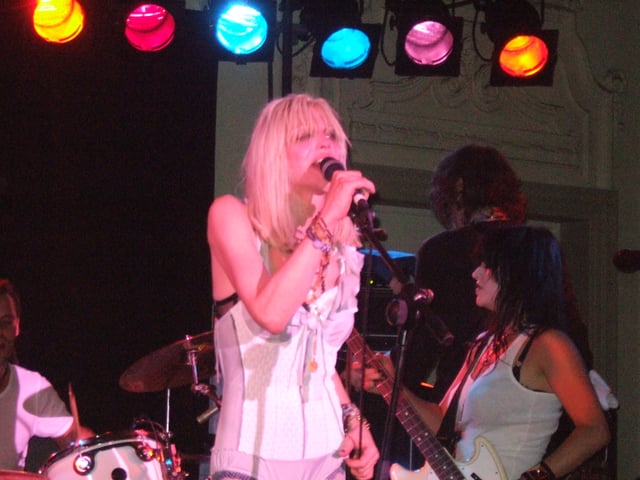
Love performing in London, 2007
After the breakup of Hole, Love began composing material with songwriter Linda Perry, and in July 2003 signed a contract with Virgin Records.[201] She began recording her new album, titled America's Sweetheart, in France shortly after.[202] A total of 32 songs were recorded during these sessions.[201] A series of legal issues simultaneously occurred during this period: In February 2003, Love had been banned from Virgin Airlines after being arrested at Heathrow Airport for disrupting a flight.[203] In October of that year, she was arrested in Los Angeles after breaking several windows of her producer and then-boyfriend James Barber's home, and was charged with being under the influence of a controlled substance;[204] the ordeal resulted in her temporarily losing custody of her daughter.[205]
Virgin Records released America's Sweetheart in February 2004, upon which it received mixed reviews.[206] Charles Aaron of Spin called it a "jaw-dropping act of artistic will and a fiery, proper follow-up to 1994's Live Through This" and awarded it eight out of ten stars,[207] while Amy Phillips of The Village Voice wrote: "[Love is] willing to act out the dream of every teenage brat who ever wanted to have a glamorous, high-profile hissyfit, and she turns those egocentric nervous breakdowns into art. Sure, the art becomes less compelling when you've been pulling the same stunts for a decade. But, honestly, is there anybody out there who fucks up better?"[208] The album sold less than 100,000 copies.[78] Love has publicly expressed her regret over the record,[209] reasoning that her drug issues at the time were to blame.[210] Shortly after the record was released, she told Kurt Loder on TRL: "I cannot exist as a solo artist. It's a joke."[211]
On March 17, 2004, Love appeared on the Late Show with David Letterman to promote the recently released America's Sweetheart.[212] Her appearance drew media coverage when, during the interview segment, she lifted her shirt multiple times,[213] flashed Letterman, and stood on his desk.[212] A New York Times article noted: "The episode was not altogether surprising for Ms. Love, 39, whose most public moments have veered from extreme pathos—like the time she read the suicide note of her famous husband, Kurt Cobain, on MTV—to angry feminism to catfights to incoherent ranting."[214] Hours later, in the early morning of March 18, Love was arrested in Manhattan for allegedly striking a 23-year-old male fan with a microphone stand during a small concert she performed at an East Village venue.[214] She was released within hours of the incident, enabling her to perform a concert scheduled for the following evening at the Bowery Ballroom.[214] Four days later, on March 22, she called in multiple times to The Howard Stern Show, claiming in broadcast conversations with Stern that the incident had not occurred, and that actress Natasha Lyonne, who was at the concert, was told by the alleged victim that he had been paid $10,000 to file a false claim leading to Love's arrest.[215][216]
On July 9, 2004, Love's 40th birthday, she was arrested for failing to make a court appearance for the March 2004 charges, and taken to Bellevue Hospital, allegedly incoherent, where she was placed on a 72-hour watch.[217] According to police, she was believed to be a potential "danger to herself," but was deemed mentally sound and released to a rehab facility two days later.[218][219] Amidst public criticism and press coverage, comedian Margaret Cho published an opinion piece on her official website in defense of Love, titled "Courtney [Love] Deserves Better from Feminists," arguing that negative associations of Love with her drug and personal problems (including from feminists) overshadowed discussion of her music and, more importantly, her personal well-being.[220] Love would ultimately plead guilty in October 2004 to disorderly conduct over the alleged striking of the audience member.[221]
Her appearance as a roaster on the Comedy Central Roast of Pamela Anderson in August 2005 attracted Love further media attention due to her appearing visibly intoxicated and disheveled.[222] One review of the program noted that Love "acted as if she belonged in a [psychiatric] institution."[222] Six days after the show's airing, she was sentenced to a 28-day lockdown rehab program for allegedly being under the influence of a controlled substance, violating her probation.[223] To avoid jail time, she accepted an additional 180-day rehab sentence in September 2005.[224] In November 2005, after successfully completing the program, Love was discharged from the rehab center under the provision that she complete further outpatient rehab.[225] In subsequent interviews in the following years, she would admit to having been dealing with various addictions during this time to prescription drugs, cocaine, and crack cocaine.[226][227] She has stated she has been sober since completing rehabilitation in 2007, and cited her Nichiren Buddhist practice (which she began in 1989)[228][229] as integral to her sobriety.[230][231]
In the midst of her legal troubles, Love had endeavors in writing and publishing: She collaborated on a semi-autobiographical manga titled Princess Ai (Japanese: プリンセス·アイ物語), which she co-wrote with Stu Levy. The manga was illustrated by Misaho Kujiradou and Ai Yazawa, and was released in three volumes in both the United States and Japan between 2004 and 2006.[232][233] Also in 2006, she published a memoir, Dirty Blonde, and began recording what would become her second solo album, How Dirty Girls Get Clean,[234] collaborating again with Perry and Smashing Pumpkins vocalist/guitarist Billy Corgan. Love had written several songs, including an anti-cocaine song titled "Loser Dust", during her time in rehab in 2005.[235] She told Billboard: "My hand-eye coordination was so bad [after the drug use], I didn't even know chords anymore. It was like my fingers were frozen. And I wasn't allowed to make noise [in rehab] ... I never thought I would work again."[236] Tracks and demos for the album (planned for release in 2008) were leaked on the internet in 2006, and a documentary entitled The Return of Courtney Love, detailing the making of the album, aired on the British television network More4 in the fall of that year. A rough acoustic version of "Never Go Hungry Again", recorded during an interview for The Times in November, was also released. Incomplete audio clips of the song "Samantha", originating from an interview with NPR, were distributed on the internet in 2007.[237]
2009–2012: Hole revival and visual art

Love with Patty Schemel (left) at the premiere of Hit So Hard at the Museum of Modern Art, 2011
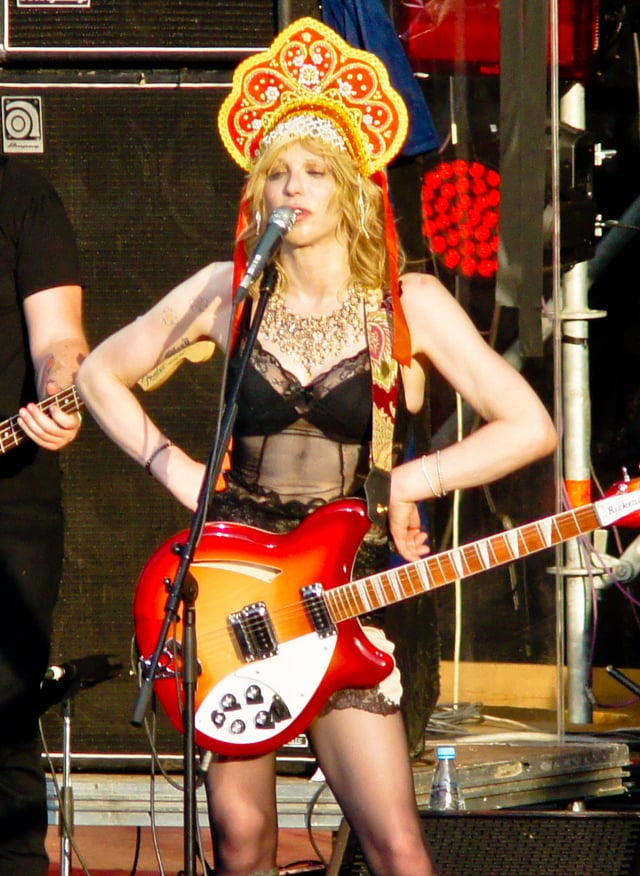
Love performing with Hole at Afisha Picnic in Moscow, 2011
In March 2009, fashion designer Dawn Simorangkir brought a libel suit against Love concerning a defamatory post Love made on her Twitter account,[238] which was eventually settled for $450,000.[239] Several months later, in June 2009, NME published an article detailing Love's plan to reunite Hole and release a new album, Nobody's Daughter.[240] In response, former Hole guitarist Eric Erlandson stated in Spin magazine that contractually no reunion could take place without his involvement; therefore Nobody's Daughter would remain Love's solo record, as opposed to a "Hole" record.[241] Love responded to Erlandson's comments in a Twitter post, claiming "he's out of his mind, Hole is my band, my name, and my Trademark".[242] Nobody's Daughter was released worldwide as a Hole album on April 27, 2010. For the new line-up, Love recruited guitarist Micko Larkin, Shawn Dailey (bass guitar), and Stu Fisher (drums, percussion). Nobody's Daughter featured material written and recorded for Love's unfinished solo album, How Dirty Girls Get Clean, including "Pacific Coast Highway", "Letter to God", "Samantha", and "Never Go Hungry", although they were re-produced in the studio with Larkin and engineer Michael Beinhorn.[243] The album's subject matter was largely centered on Love's tumultuous life between 2003 and 2007, and featured a polished folk rock sound, and more acoustic guitar work than previous Hole albums.[244]
The first single from Nobody's Daughter was "Skinny Little Bitch", released to promote the album in March 2010.[245] The album received mixed reviews.[246] Robert Sheffield of Rolling Stone gave the album three out of five, saying Love "worked hard on these songs, instead of just babbling a bunch of druggy bullshit and assuming people would buy it, the way she did on her 2004 flop, America's Sweetheart".[247] Sal Cinquemani of Slant Magazine also gave the album three out of five: "It's Marianne Faithfull's substance-ravaged voice that comes to mind most often while listening to songs like 'Honey' and 'For Once in Your Life'. The latter track is, in fact, one of Love's most raw and vulnerable vocal performances to date ... the song offers a rare glimpse into the mind of a woman who, for the last 15 years, has been as famous for being a rock star as she's been for being a victim."[248] Love and the band toured internationally from 2010 into late 2012 promoting the record, with their pre-release shows in London and at South by Southwest receiving critical acclaim.[209] In 2011, Love participated in Hit So Hard, a documentary chronicling bandmate Schemel's time in Hole.[102]
In May 2012, Love debuted an art collection at Fred Torres Collaborations in New York titled "And She's Not Even Pretty",[249] which contained over forty drawings and paintings by Love composed in ink, colored pencil, pastels, and watercolors.[250][251] Later in the year, she collaborated with Michael Stipe on the track "Rio Grande" for Johnny Depp's sea shanty album Son of Rogues Gallery,[252] and in 2013, co-wrote and contributed vocals on "Rat A Tat" from Fall Out Boy's album Save Rock and Roll, also appearing in the song's music video.[253]
2013–2015: Return to acting; libel lawsuits
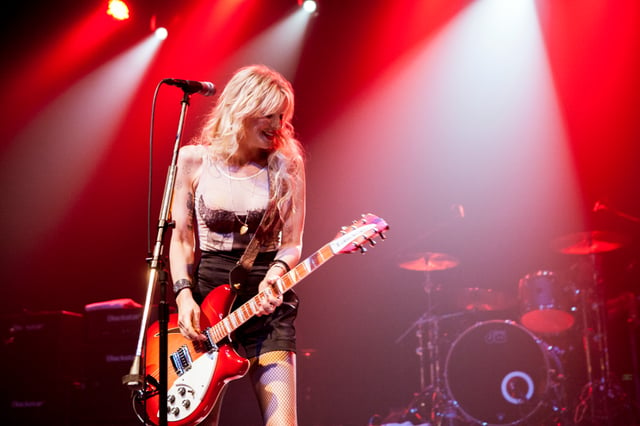
Love performing in Ventura, California, 2015
After dropping the Hole name and performing as a solo artist[254] in late 2012,[255] Love appeared in spring 2013 advertisements for Yves Saint Laurent alongside Kim Gordon and Ariel Pink.[256] Love completed a solo tour of North America in mid-2013,[257][258] which was purported to be in promotion of an upcoming solo album; however, it was ultimately dubbed a "greatest hits" tour, and featured songs from Love's and Hole's back catalogue.[259] Love told Billboard at the time that she had recorded eight songs in the studio.[260]
Love was subject of a second landmark libel lawsuit brought against her in January 2014 by her former attorney Rhonda Holmes, who accused Love of online defamation, seeking $8 million in damages.[261] It was the first case of alleged Twitter-based libel in U.S. history to make it to trial.[262] The jury, however, found in Love's favor.[261] A subsequent defamation lawsuit filed by fashion Simorangkir in February 2014, however, resulted in Love being ordered to pay a further $350,000 in recompense.[239]
On April 22, 2014, Love debuted the song "You Know My Name" on BBC Radio 6 to promote her tour of the United Kingdom.[263] It was released as a double A-side single with the song "Wedding Day" on May 4, 2014, on her own label Cherry Forever Records via Kobalt Label Services.[264] The tracks were produced by Michael Beinhorn, and feature Tommy Lee on drums.[265] In an interview with the BBC, Love revealed that she and former Hole guitarist Eric Erlandson had reconciled, and had been rehearsing new material together, along with former bassist Melissa Auf der Maur and drummer Patty Schemel, though she did not confirm a reunion of the band.[266] On May 1, 2014, in an interview with Pitchfork, Love commented further on the possibility of Hole reuniting, saying: "I'm not going to commit to it happening, because we want an element of surprise. There's a lot of is to be dotted and ts to be crossed."[267][268]
Love was cast in several television series in supporting parts throughout 2014 including the FX series Sons of Anarchy,[269] Revenge,[270] and Lee Daniels' network series Empire in a recurring guest role as Elle Dallas.[271] The track "Walk Out on Me" featuring Love was included on the Empire: Original Soundtrack from Season 1 album, which debuted at number 1 on the Billboard 200.[272] Alexis Petridis of The Guardian praised the track, saying: "The idea of Courtney Love singing a ballad with a group of gospel singers seems faintly terrifying ... the reality is brilliant. Love's voice fits the careworn lyrics, effortlessly summoning the kind of ravaged darkness that Lana Del Rey nearly ruptures herself trying to conjure up."[273]
In January 2015, Love starred in a New York City stage production titled Kansas City Choir Boy, a "pop opera" conceived by and co-starring Todd Almond.[274] Charles Isherwood of The New York Times praised her performance, noting a "soft-edged and bewitching" stage presence, adding: "Her voice, never the most supple or rangy of instruments, retains the singular sound that made her an electrifying front woman for the band Hole: a single sustained noted can seem to simultaneously contain a plea, a wound and a threat."[275] The show toured later in the year, with performances in Boston and Los Angeles.[276] Love saw further legal troubles in April 2015 when journalist Anthony Bozza sued her over an alleged contractual violation regarding his co-writing of her memoir.[277] Love subsequently joined Lana Del Rey on her Endless Summer Tour, performing as an opener on the tour's eight West Coast shows in May–June 2015.[278] During her tenure on Del Rey's tour, Love debuted a new single, "Miss Narcissist", released on Wavves' independent label Ghost Ramp.[279] She also was cast in a supporting role in James Franco's film The Long Home, based on William Gay's novel of the same name, marking her first film role in over ten years.[280]
2016–present: Fashion and other legal troubles
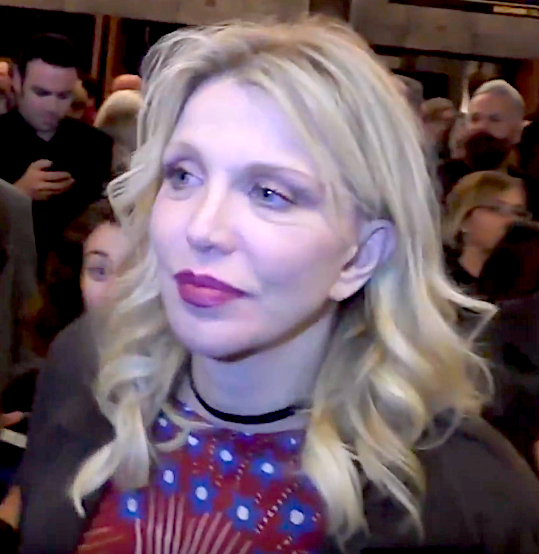
Love in 2016
In January 2016, Love released a clothing line in collaboration with Sophia Amoruso titled "Love, Courtney", featuring eighteen pieces reflecting her personal style.[281] In November 2016, she began filming the pilot for A Midsummer's Nightmare, a Shakespeare anthology series adapted for Lifetime.[282] She then starred as Kitty Menendez in Menendez: Blood Brothers, a biopic television film based on the lives of Lyle and Erik Menendez, which premiered on Lifetime in June 2017.[283] The same year, she was cast in Justin Kelly's biopic JT LeRoy, opposite Laura Dern, Kristen Stewart, Diane Kruger, and Kelvin Harrison Jr..[284] In March 2018, Love appeared in the music video for Marilyn Manson's "Tattooed in Reverse,"[285] which she followed with an April 5 guest-judge appearance on RuPaul's Drag Race.[286]
In December 2018, Love filed and was awarded a restraining order against Sam Lutfi, who had acted as her manager for the previous six years, alleging verbal abuse and harassment.[287] Her daughter, Frances, and sister, Jaimee, were also awarded restraining orders against Lutfi.[287] In January 2019, a Los Angeles County judge extended the three-year duration of the order to a total of five years, citing Lutfi's apparent tendency to "prey upon people."[288]
On August 18, 2019, Love performed a solo set at the Yola Día festival in Los Angeles, which also featured performances by Cat Power and Lykke Li.[289] On September 9, Love garnered press attention when she publicly criticized Joss Sackler, an heiress to the Sackler family OxyContin fortune, after she allegedly offered Love $100,000 to attend her fashion show during New York Fashion Week.[290] In a statement condemning Sackler, Love commented: "I am one of the most famous reformed junkies on the planet – my husband died on heroin – What is it about me that says to Joss Sackler, ’I will sell out to you?’ Well I won’t. I never would take their money — Joss is delusional, talking about her fashion line and private members club, their ‘philanthropical arm’. What about instead giving money to rehab facilities, paying for Narcan, or creating a non-addictive painkiller?"[290] In the same statement, Love indicated that she had relapsed into opioid addiction in 2018, stating that she had recently celebrated a year of sobriety.[290]
Artistry
Influences
Love has been candid about her diverse musical influences, the earliest being Patti Smith, The Runaways, and The Pretenders, artists she discovered while in juvenile hall at age fifteen.[291] As a child, her first exposure to music was records that her parents retrieved each month through Columbia Record Club.[292] The first record Love owned was Leonard Cohen's Songs of Leonard Cohen (1967), which she obtained from her mother: "He was so lyric-conscious and morbid, and I was a pretty morbid kid," she recalled.[292] As a teenager, she named Flipper, Kate Bush, Soft Cell, Joni Mitchell, Laura Nyro,[293] Lou Reed, and Dead Kennedys among her favorite artists.[48] She has also spoken of her appreciation for new wave and post-punk bands she became acquainted with while living as a teenager in the United Kingdom, such as Echo and the Bunnymen,[294] The Smiths,[295] Siouxsie and the Banshees,[296] Television,[296] Bauhaus,[295] and Joy Division.[297]
While in Dublin at age fifteen, Love attended a Virgin Prunes concert, an event she credited as being a pivotal influence: "I had never seen so much sex, snarl, poetry, evil, restraint, grace, filth, raw power and the very essence of rock and roll," she recalled. "[I had seen] U2 [who] gave me lashes of love and inspiration, and a few nights later the Virgin Prunes fucked–me–up."[298] Decades later, in 2009, Love introduced the band's frontman Gavin Friday at a Carnegie Hall event, and performed a song with him.[298]
Love's diverse genre interests were illustrated in a 1991 interview with Flipside, in which she stated: "There's a part of me that wants to have a grindcore band and another that wants to have a Raspberries-type pop band."[87] Discussing the abrasive sound of Hole's debut album, she said she felt she had to "catch up with all my hip peers who'd gone all indie on me, and who made fun of me for liking R.E.M. and The Smiths."[293] She has also embraced the influence of experimental artists and punk rock groups, including Sonic Youth, Swans,[299] Big Black, Diamanda Galás,[300] the Germs, and The Stooges.[301] While writing Celebrity Skin, she drew influence from Neil Young and My Bloody Valentine.[176] She has also cited her contemporary PJ Harvey as an influence, saying: "The one rock star that makes me know I'm shit is Polly Harvey. I'm nothing next to the purity that she experiences."[302] In 2014, she named "Bitter Sweet Symphony" by The Verve as one of her favorite songs.[292]
Literature and poetry have often been a major influence on her songwriting; Love said she had "always wanted to be a poet, but there was no money in it."[303] She has named the works of T.S. Eliot and Charles Baudelaire as influential,[38][304] and referenced works by Dante Rossetti,[305] William Shakespeare,[306] Rudyard Kipling, and Anne Sexton in her lyrics.[307]
Musical style and lyrics
Musically, Love's work with Hole and her solo efforts have been characterized as alternative rock;[308] Hole's early material, however, was described by critics as being stylistically closer to grindcore and aggressive punk rock.[309] Spin's October 1991 review of Hole's first album noted Love's layering of harsh and abrasive riffs buried more sophisticated musical arrangements.[310] In 1998, she stated that Hole had "always been a pop band. We always had a subtext of pop. I always talked about it, if you go back ... what'll sound like some weird Sonic Youth tuning back then to you was sounding like the Raspberries to me, in my demented pop framework."[176]
Love's lyrical content is composed from a female's point of view,[311] and her lyrics have been described as "literate and mordant"[312] and noted by scholars for "articulating a third-wave feminist consciousness."[313] Simon Reynolds, in reviewing Hole's debut album, noted: "Ms. Love's songs explore the full spectrum of female emotions, from vulnerability to rage. The songs are fueled by adolescent traumas, feelings of disgust about the body, passionate friendships with women and the desire to escape domesticity. Her lyrical style could be described as emotional nudism."[311] Journalist and critic Kim France, in critiquing Love's lyrics, referred to her as a "dark genius" and likened her work to that of Anne Sexton.[314]
Love has remarked that lyrics have always been the most important component of songwriting for her: "The important thing for me... is it has to look good on the page. I mean, you can love Led Zeppelin and not love their lyrics... but I made a big effort in my career to have what's on the page mean something."[315] A great deal of her songwriting has been diaristic in nature.[316] Common themes present in Love's songs during her early career included body image, rape, suicide, conformity, elitism, pregnancy, prostitution, and death. In a 1991 interview with Everett True, she said: "I try to place [beautiful imagery] next to fucked up imagery, because that's how I view things ... I sometimes feel that no one's taken the time to write about certain things in rock, that there's a certain female point of view that's never been given space."[317]
Critics have noted that Love's later musical work is more lyrically introspective.[318] Celebrity Skin and America's Sweetheart are lyrically centered on celebrity life, Hollywood, and drug addiction, while continuing Love's interest in vanity and body image. Nobody's Daughter was lyrically reflective of Love's past relationships and her struggle for sobriety, with the majority of its lyrics written while she was in rehab in 2006.[319]
Performance
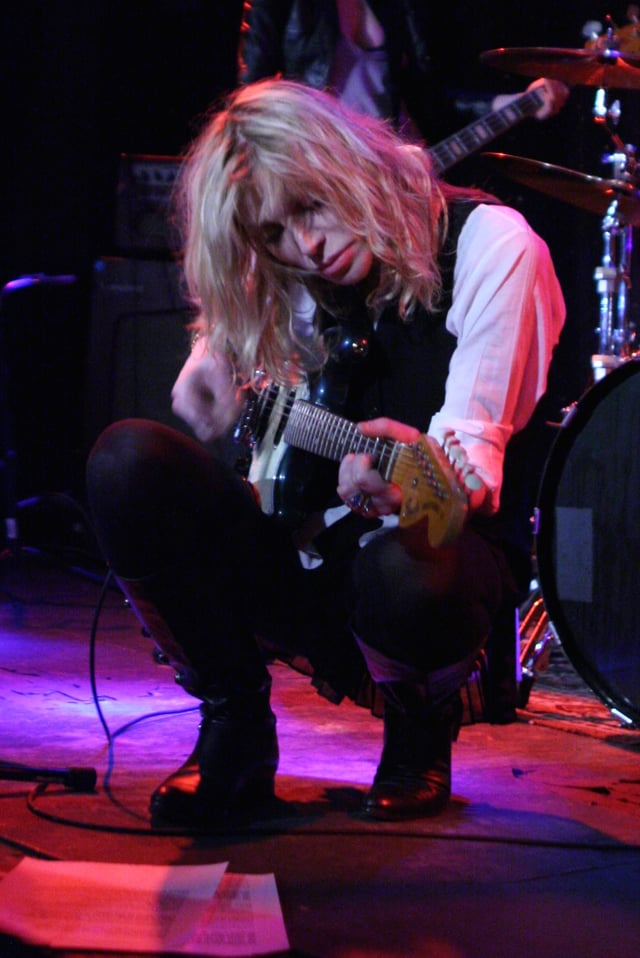
Love, pictured playing a Fender Mustang in 2012, has often played both Fender and Rickenbacker guitars throughout her career
Love possesses a contralto vocal range.[320] According to Love, she never wanted to be a singer, but rather aspired to be a skilled guitarist: "I'm such a lazy bastard though that I never did that," she said. "I was always the only person with the nerve to sing, and so I got stuck with it."[38] She has been regularly noted by critics for her husky vocals as well as her "banshee [-like]" screaming abilities.[321][322] Her vocals have been compared to those of Johnny Rotten,[323][324] and David Fricke of Rolling Stone described them as "lung-busting" and "a corrosive, lunatic wail."[323] Upon the release of Hole's 2010 album, Nobody's Daughter, Amanda Petrusich of Pitchfork compared Love's raspy, unpolished vocals to those of Bob Dylan.[325]
She has played a variety of Fender guitars throughout her career, including a Jaguar and a vintage 1965 Jazzmaster; the latter was purchased by the Hard Rock Cafe and is on display in New York City.[326] Between 1989 and 1991, Love primarily played a Rickenbacker 425[327] because she "preferred the 3/4 neck,"[186] but she destroyed the guitar onstage at a 1991 concert opening for The Smashing Pumpkins.[109] In the mid-1990s, she often played a guitar made by Mercury, an obscure company that manufactured custom guitars,[187] as well as a Univox Hi-Flier.[328] Fender's Vista Venus, designed by Love in 1998, was partially inspired by Rickenbacker guitars as well as her Mercury.[187] During tours after the release of Nobody's Daughter (post-2010), Love has played a Rickenbacker 360 onstage.[329] Her setup has included Fender tube gear, Matchless, Ampeg, Silvertone and a solid-state 1976 Randall Commander.[186]
Love has referred to herself as "a shit guitar player," further commenting in a 2014 interview: "I can still write a song, but [the guitar playing] sounds like shit ... I used to be a good rhythm player but I am no longer dependable."[330] Throughout her career, she has also garnered a reputation for unpredictable live shows.[151] In the 1990s, her performances with Hole were characterized by confrontational behavior, with Love stage diving, smashing guitars[109] or throwing them into the audience,[331] wandering into the crowd at the end of sets,[331] and engaging in sometimes incoherent rants.[152] Critics and journalists have noted Love for her comical, often stream-of-consciousness-like stage banter.[332][333] In a review of a live performance published in 2010, it was noted that Love's onstage "one-liners [were] worthy of the Comedy Store."[333]
Philanthropy
In 1993, Love and husband Kurt Cobain performed an acoustic set together at the Rock Against Rape benefit in Los Angeles, which raised awareness and provided resources for victims of sexual abuse.[137] In 2000, Love publicly advocated for reform of the record industry in a personal letter published by Salon.[334] In the letter, Love said: "It's not piracy when kids swap music over the Internet using Napster or Gnutella or Freenet or iMesh or beaming their CDs into a My.MP3.com or MyPlay.com music locker. It's piracy when those guys that run those companies make side deals with the cartel lawyers and label heads so that they can be 'the label's' friend', and not the artists."[334] In a subsequent interview with Carrie Fisher, she said that she was interested in starting a union for recording artists,[16] and also discussed race relations in the music industry, advocating for record companies to "put money back into the black community [whom] white people have been stealing from for years."[335]
Love has been a long-standing supporter of LGBT causes.[336] She has frequently collaborated with Los Angeles Gay and Lesbian Center, taking part in the center's "An Evening with Women" events.[337] The proceeds of the event help provide food and shelter for homeless youth; services for seniors; legal assistance; domestic violence services; health and mental health services, and cultural arts programs. Love participated with Linda Perry for the event in 2012, and performed alongside Aimee Mann and comedian Wanda Sykes. Speaking on her collaboration on the event, Love said: "Seven thousand kids in Los Angeles a year go out on the street, and forty percent of those kids are gay, lesbian, or transgendered. They come out to their parents, and become homeless... for whatever reason, I don't really know why, but gay men have a lot of foundations—I've played many of them—but the lesbian side of it doesn't have as much money and/or donors, so we're excited that this has grown to cover women and women's affairs."[338]
She has also contributed to AIDS organizations, partaking in benefits for amfAR[339] and the RED Campaign.[340] In May 2011, she donated six of her husband Cobain's personal vinyl records for auction at Mariska Hargitay's Joyful Heart Foundation event for victims of child abuse, rape, and domestic violence.[341] She has also supported the Sophie Lancaster Foundation.[342]
Influence
Love has had an impact on female-fronted alternative acts and performers.[344] She has been cited as influential on young female instrumentalists in particular,[345] having once infamously proclaimed: "I want every girl in the world to pick up a guitar and start screaming...[346] I strap on that motherfucking guitar and you cannot fuck with me. That's my feeling."[347] In The Electric Guitar: A History of an American Icon, it is noted:
[Love] truly lived up to Paul Westerberg's (The Replacements) assessment of pretty girls 'playing makeup/wearing guitar' ... She frequently stood on stage, microphone in hand and foot on monitor, and simply let her Fender guitar dangle around her neck. She truly embodied the empowerment that came with playing the electric guitar ... Love depended heavily upon her male lead guitar foil Eric Erlandson, but the rest of her band remained exclusively female throughout several lineup changes.[343]
"When you're dying and your life is flashing before your eyes... you're gonna be thinking about the great things you did, the horrible things that you did, the emotional impact that someone had on you and that you had on somebody else. Those are the things that are relevant. To have some sort of emotional impact that transcends time, that's great." –Love on having a cultural impact, 1997[348]
With over 3 million records sold in the United States alone,[4] Hole became one of the most successful rock bands of all time fronted by a woman.[345][350] VH1 ranked Love no. 69 in their list of The 100 Greatest Women in Music History in 2012.[351] In 2015, the Phoenix New Times declared Love the number one greatest female rock star of all time, writing: "To build a perfect rock star, there are several crucial ingredients: musical talent, physical attractiveness, tumultuous relationships, substance abuse, and public meltdowns, just to name a few. These days, Love seems to have rebounded from her epic tailspin and has leveled out in a slightly more normal manner, but there's no doubt that her life to date is the type of story people wouldn't believe in a novel or a movie."[352]
Among the alternative musicians who have cited Love as an influence are Scout Niblett;[353] Brody Dalle of The Distillers;[354] Dee Dee Penny of Dum Dum Girls;[355] and Nine Black Alps.[356] Contemporary female pop artists Lana Del Rey,[357] Avril Lavigne,[358] Tove Lo,[359] and Sky Ferreira[360] have also cited Love as an influence. Love has frequently been recognized as the most high-profile contributor of feminist music during the 1990s,[361] and for "subverting [the] mainstream expectations of how a woman should look, act, and sound."[362] According to music journalist Maria Raha, "Hole was the highest-profile female-fronted band of the '90s to openly and directly sing about feminism."[363] Patti Smith, a major influence of Love's, also praised her, saying: "I hate genderizing things ... [but] when I heard Hole, I was amazed to hear a girl sing like that. Janis Joplin was her own thing; she was into Big Mama Thornton and Bessie Smith. But what Courtney Love does, I'd never heard a girl do that."[364]
She has also been a gay icon since the mid-1990s,[365] and has jokingly referred to her fanbase as consisting of "females, gay guys, and a few advanced, evolved heterosexual men."[331] Love's aesthetic image, particularly in the early 1990s, also became influential, and was dubbed "kinderwhore" by critics and media. The subversive fashion mainly consisted of vintage babydoll dresses accompanied by smeared makeup and red lipstick.[97][366] MTV reporter Kurt Loder described Love as looking like "a debauched rag doll" onstage.[367][368] Love later said she had been influenced by the fashion of Chrissy Amphlett of the Divinyls.[369] Interviewed in 1994, Love commented "I would like to think–in my heart of hearts–that I'm changing some psychosexual aspects of rock music. Not that I'm so desirable. I didn't do the kinder-whore thing because I thought I was so hot. When I see the look used to make one more appealing, it pisses me off. When I started, it was a What Ever Happened to Baby Jane? thing. My angle was irony." [370]
Works
Hole discography
Pretty on the Inside (1991)
Live Through This (1994)
Celebrity Skin (1998)
Nobody's Daughter (2010)
Solo discography
America's Sweetheart (2004)
Filmography
Bibliography
Levy, Stu; Love, Courtney (2004). Princess Ai: Destitution. 1. Tokyopop [Japan: Shinshokan]. ISBN 978-1-59182-669-9.
Levy, Stu; Love, Courtney (2005). Princess Ai: Lumination. 2. Tokyopop [Japan: Shinshokan]. ISBN 978-1-59182-670-5.
Levy, Stu; Love, Courtney (2006). Princess Ai: Evolution [383] . 3. Tokyopop [Japan: Shinshokan]. ISBN 978-1-59182-671-2.
Love, Courtney (2006). Dirty Blonde: The Diaries of Courtney Love. Faber & Faber. ISBN 978-0-86547-959-3.







